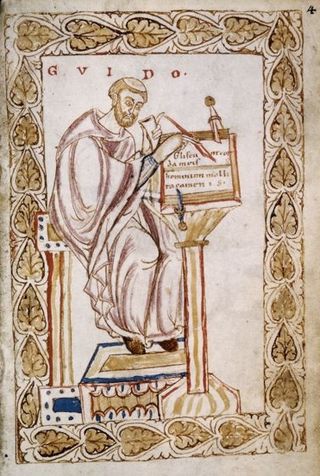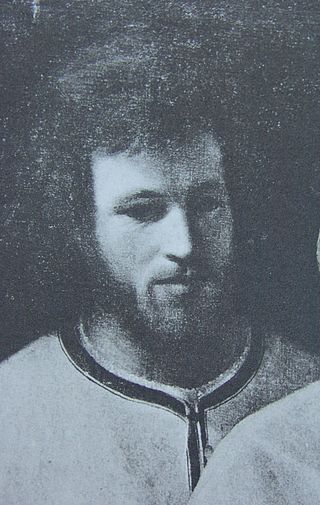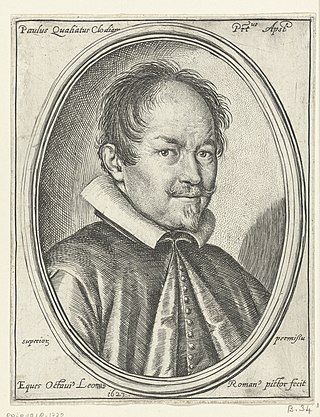Related Research Articles

Claudio Giovanni Antonio Monteverdi was an Italian composer, choirmaster and string player. A composer of both secular and sacred music, and a pioneer in the development of opera, he is considered a crucial transitional figure between the Renaissance and Baroque periods of music history.

Guido of Arezzo was an Italian music theorist and pedagogue of High medieval music. A Benedictine monk, he is regarded as the inventor—or by some, developer—of the modern staff notation that had a massive influence on the development of Western musical notation and practice. Perhaps the most significant European writer on music between Boethius and Johannes Tinctoris, after the former's De institutione musica, Guido's Micrologus was the most widely distributed medieval treatise on music.

Arezzo is a city and comune in Italy and the capital of the province of the same name located in Tuscany. Arezzo is about 80 kilometres southeast of Florence at an elevation of 296 metres (971 ft) above sea level. As of 2022, the population was about 97,000.
Giaches de Wert was a Franco-Flemish composer of the late Renaissance, active in Italy. Intimately connected with the progressive musical center of Ferrara, he was one of the leaders in developing the style of the late Renaissance madrigal. He was one of the most influential of late sixteenth-century madrigal composers, particularly on Claudio Monteverdi, and his later music was formative on the development of music of the early Baroque era.

A madrigal is a form of secular vocal music most typical of the Renaissance and early Baroque (1600–1750) periods, although revisited by some later European composers. The polyphonic madrigal is unaccompanied, and the number of voices varies from two to eight, but usually features three to six voices, whilst the metre of the madrigal varies between two or three tercets, followed by one or two couplets. Unlike the verse-repeating strophic forms sung to the same music, most madrigals are through-composed, featuring different music for each stanza of lyrics, whereby the composer expresses the emotions contained in each line and in single words of the poem being sung.

Philippe Verdelot was a French composer of the Renaissance, who spent most of his life in Italy. He is commonly considered to be the father of the Italian madrigal, and certainly was one of its earliest and most prolific composers; in addition he was prominent in the musical life of Florence during the period after the recapture of the city by the Medici from the followers of Girolamo Savonarola.

Luca Marenzio was an Italian composer and singer of the late Renaissance.

Pietro Aretino was an Italian author, playwright, poet, satirist and blackmailer, who wielded influence on contemporary art and politics. He was one of the most influential writers of his time and an outspoken critic of the powerful. Owing to his communications and sympathies with religious reformers, he is considered to have been a Nicodemite Protestant.

Spinello Aretino was an Italian painter from Arezzo, who was active in Tuscany at the end of the 14th and the first decennium of the 15th century. His style influenced the development of late 14th- and early 15th-century painting in Tuscany.

Paolo Quagliati was an Italian composer of the early Baroque era and a member of the Roman School of composers. He was a transitional figure between the late Renaissance style and the earliest Baroque and was one of the first to write solo madrigals in the conservative musical center of Rome.
Claudio Pari was an Italian composer, of Burgundian birth, of the late Renaissance and early Baroque eras. He was a competent madrigalist, well regarded by his peers, as well as a late representative of the musical style/ethos known as musica reservata.

Andrea della Robbia was an Italian Renaissance sculptor, especially in ceramics.

The Lives of the Most Excellent Painters, Sculptors, and Architects, often simply known as The Lives, is a series of artist biographies written by 16th-century Italian painter and architect Giorgio Vasari, which is considered "perhaps the most famous, and even today the most-read work of the older literature of art", "some of the Italian Renaissance's most influential writing on art", and "the first important book on art history".
Hoste da Reggio was an Italian composer of the Renaissance, active in Milan and elsewhere in northern Italy. He was well known for his madrigals, which were published in several collections in Venice.
Ippolito Ciera was an Italian composer of the Renaissance, active at Treviso and Venice.
Giovanni Priuli was a Venetian composer and organist of the late Renaissance and early Baroque periods. A late member of the Venetian School, and a contemporary of Claudio Monteverdi, he was a prominent musician in Venice in the first decade of the 17th century, departing after the death of his associate Giovanni Gabrieli and ending his career at the Habsburg court in Austria. His music straddled the dividing-line between Renaissance and Baroque idioms.
Nicolao Dorati was an Italian composer and trombone player of the Renaissance, active in Lucca. Although he was primarily an instrumentalist, all of his published music is vocal, and consists mainly of madrigals.
Ippolito Chamaterò was an Italian composer of the late Renaissance, originally from Rome but active in northern Italy. He wrote both sacred and secular music, particularly madrigals; all of his surviving music is vocal. His sacred musical style was in conformance with the Counter-Reformation musical ideals following the Council of Trent, and his madrigals were related stylistically to those of Adrian Willaert and Cipriano de Rore.

Girolamo Scotto was an Italian printer, composer, businessman and bookseller of the Renaissance, active mainly in Venice. He was the most influential member of the firm of Venetian printers, the House of Scotto, which existed from the late 15th century until 1615. At its peak in the 1560s, the Scotto firm under Girolamo was one of the preeminent publishing firms of Europe, producing volumes on law, scholasticism, philosophy, medicine, theology, and ancient literature in addition to music. Only the firm of Gardano produced more books of music in the 16th century than the House of Scotto under Girolamo; over half of Scotto's publications, 409 out of approximately 800 in total, were books of music.
References
- ↑ Thompson, Oscar; Slonimsky, Nicolas (1946). The International cyclopedia of music and musicians.
- ↑ Bernstein, Jane A. (1998). Music printing in Renaissance Venice: the Scotto Press, 1539-1572. Oxford University Press. ISBN 9780195102314 . Retrieved 26 August 2011.
- ↑ Burney, Charles (1789). A General History of Music: from the earliest ages to the present period, Volume 3. Payne and Sons. p. 182.